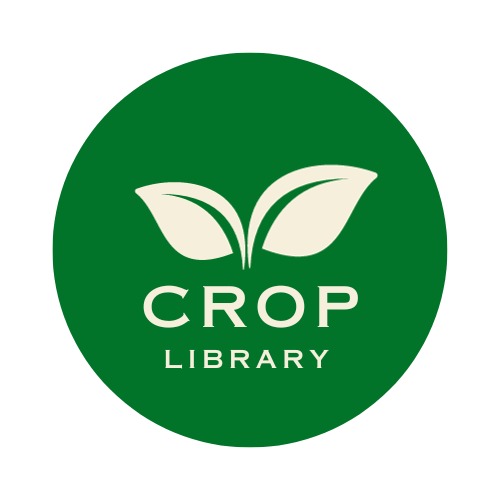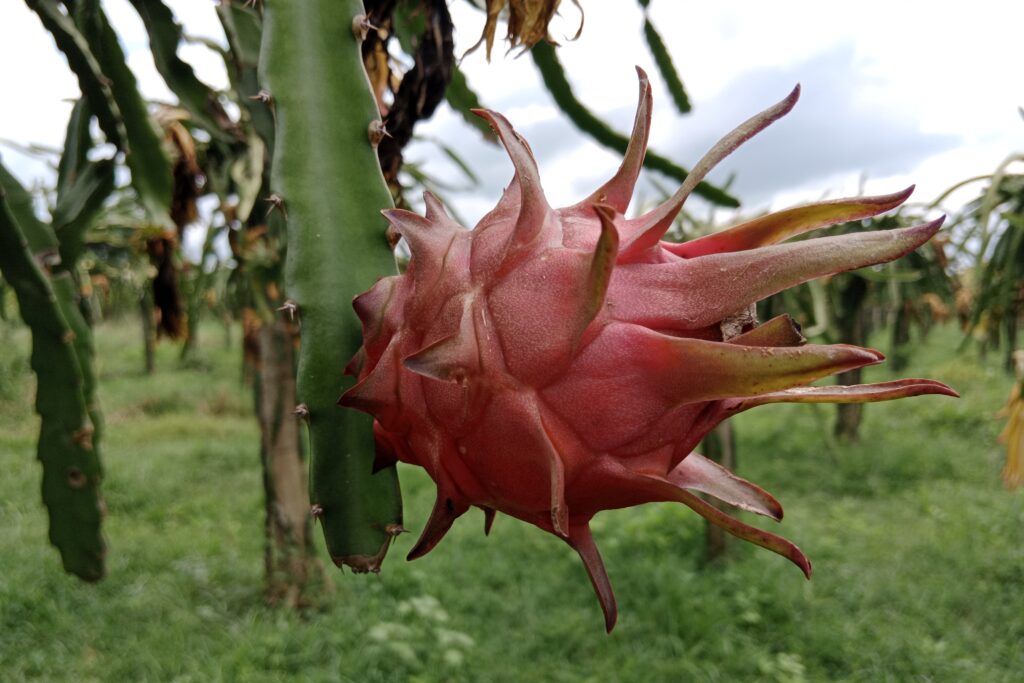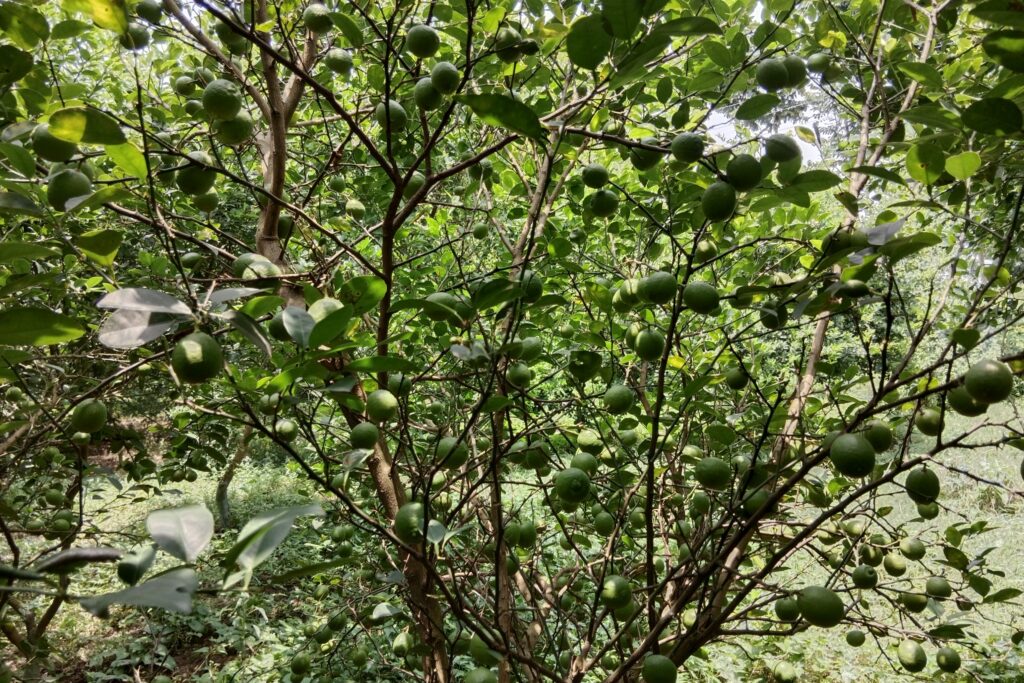Artichoke Farming
Artichoke farming is a high-value horticultural practice focused on cultivating the edible flower buds of Cynara scolymus. Known for its nutritional and medicinal benefits, artichoke thrives in well-drained soils and moderate, frost-free climates. With proper management of irrigation, nutrients, and pest control, it offers farmers a sustainable source of income and significant long-term profitability.
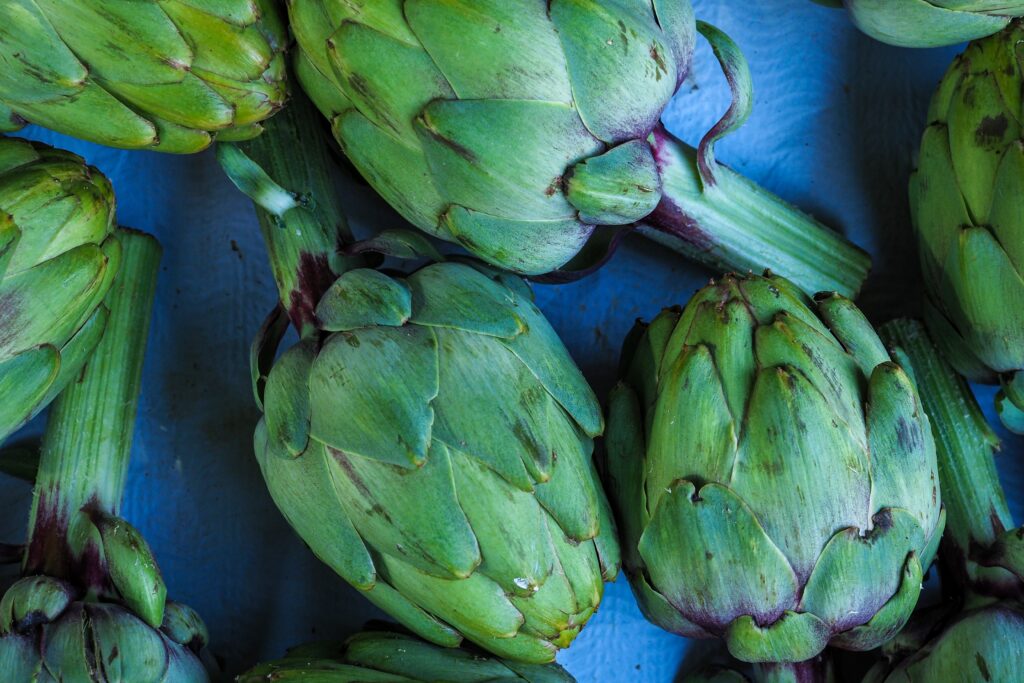
Artichoke cultivation is a high-value horticultural enterprise centered on producing the immature flower buds of Cynara scolymus. Valued for its nutritional and medicinal properties, artichoke commands strong demand in both domestic and international markets, offering significant economic potential for growers.
The crop performs best in well-drained soils under moderate, frost-free climates and requires precise management of irrigation, nutrients, pest, and disease control to achieve optimal productivity. With strategic planning and appropriate investment, artichoke farming can deliver sustainable income and long-term profitability.
Artichoke farming profit per acre can be highly rewarding despite the high initial investment and first-year loss. With a startup cost of NRs. 76,000 and additional annual maintenance expenses, farmers may face a net loss in the first year; however, the investment is typically recovered by the second year, with cumulative profits turning positive.
Yield and profitability peak in the third year, remain strong in the fourth, and gradually decline in the fifth, resulting in a total net profit of NRs. 595,640 over a five-year cycle. This demonstrates that, with proper management and patience, artichoke cultivation can offer excellent long-term returns per acre.
Land Preparation
Land preparation is a vital step in establishing a healthy and long-lasting artichoke plantation, which can remain productive for 5–7 years. The process begins with deep plowing (18–24 inches) to break hardpans and promote extensive root growth, followed by repeated harrowing to break down soil clods and create a fine tilth. Proper leveling of the field is essential to ensure uniform water distribution and prevent waterlogging, while basins or trenches are prepared according to the chosen irrigation system, such as furrow irrigation, to facilitate efficient water management.
Soil Type
Artichokes grow best in deep, well-drained, fertile sandy loam or loam soils, as proper drainage is critical to prevent root rot, a common issue in waterlogged conditions. Heavy clay soils are generally unsuitable unless extensively amended with organic matter to enhance drainage. The ideal soil pH ranges from 6.0 to 7.0, slightly acidic to neutral, and artichokes also show moderate tolerance to saline conditions.
Climatic Requirements
Artichokes are cool-season perennials that thrive in moderate, frost-free climates with mild winters and cool, foggy summers, typical of Mediterranean regions. Optimal growth occurs at day temperatures of 18–24°C (65–75°F) and night temperatures of 12–14°C (55–58°F). For successful flowering and bud production, plants require vernalization—a chilling period of 10–12 days at temperatures below 10°C (50°F). While established plants can withstand light frost, severe frost damages buds and leaves, and excessive summer heat above 30°C (86°F) can make buds tough and cause them to open prematurely.
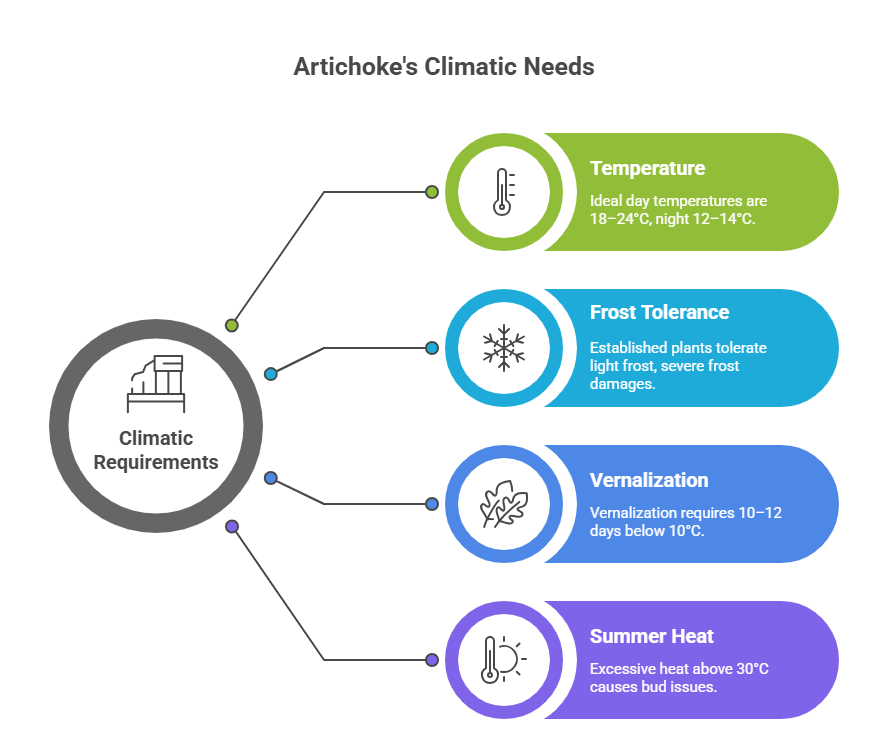
Major Artichoke Cultivars
Cultivar choice depends on the region, market preference (green vs. purple), and growing method (annual vs. perennial).
| Cultivar Name | Key Characteristics | Adaptability / Special Features | Vernalization Requirement |
| Green Globe | Classic, large, round, green variety. Thick, fleshy bracts. High yield. | The traditional standard variety. | Requires vernalization. |
| Imperial Star | Bred for annual production from seed. | Highly adaptable. Easier to vernalize than Green Globe. | Vernalizes easily. |
| Big Heart | Thornless, heat-tolerant variety. | Suitable for warmer climates. Can be grown as an annual. | Can be grown as an annual. |
| Violetto | Italian heirloom. Elongated, conical shape. Beautiful purple color. | Valued for its tenderness and flavor. | Not specified. |
Propagation
Artichokes are propagated mainly through two methods: vegetative propagation using offshoots or “suckers” and seed propagation. The traditional method for perennial cultivation involves selecting healthy, disease-free offshoots, 5–8 inches long with roots, from established mother plants to ensure genetic uniformity and preserve cultivar characteristics. Seed propagation, on the other hand, is gaining popularity for annual production, particularly with modern cultivars like ‘Imperial Star,’ as it is cost-effective and reduces the risk of soil-borne diseases.
Seed Rate per Acre
When growing from seed, approximately 450g -650g of seed per acre is required. This accounts for raising seedlings in a nursery before transplanting.
Nursery Management
Sowing
Artichoke seeds are usually started in well-prepared nursery beds or, more commonly, in plug trays filled with a sterile, soilless potting mix that ensures healthy germination and disease-free seedlings.
Vernalization of Seedlings
To encourage flowering in the first year, seedlings undergo vernalization. At the stage of 2–4 true leaves, they are exposed to low temperatures between 2–10°C (35–50°F) for 10–14 days, which triggers the flowering process.
Hardening Off
Before transplanting to the main field, seedlings are hardened by gradually adapting them to outdoor conditions. This is done by reducing irrigation and increasing exposure to sunlight over a period of 7–10 days, making them more resilient to field conditions.
Transplanting Age
Seedlings are ready for field planting at 6–8 weeks after sowing, once they reach a height of 8–10 inches and develop 5–6 true leaves, ensuring strong establishment and better growth in the main field.
Planting
a). Planting Season
In perennial systems, artichoke offshoots are usually planted in late fall or early spring, while in annual systems, vernalized seedlings are transplanted in early spring immediately after the risk of hard frost has passed.
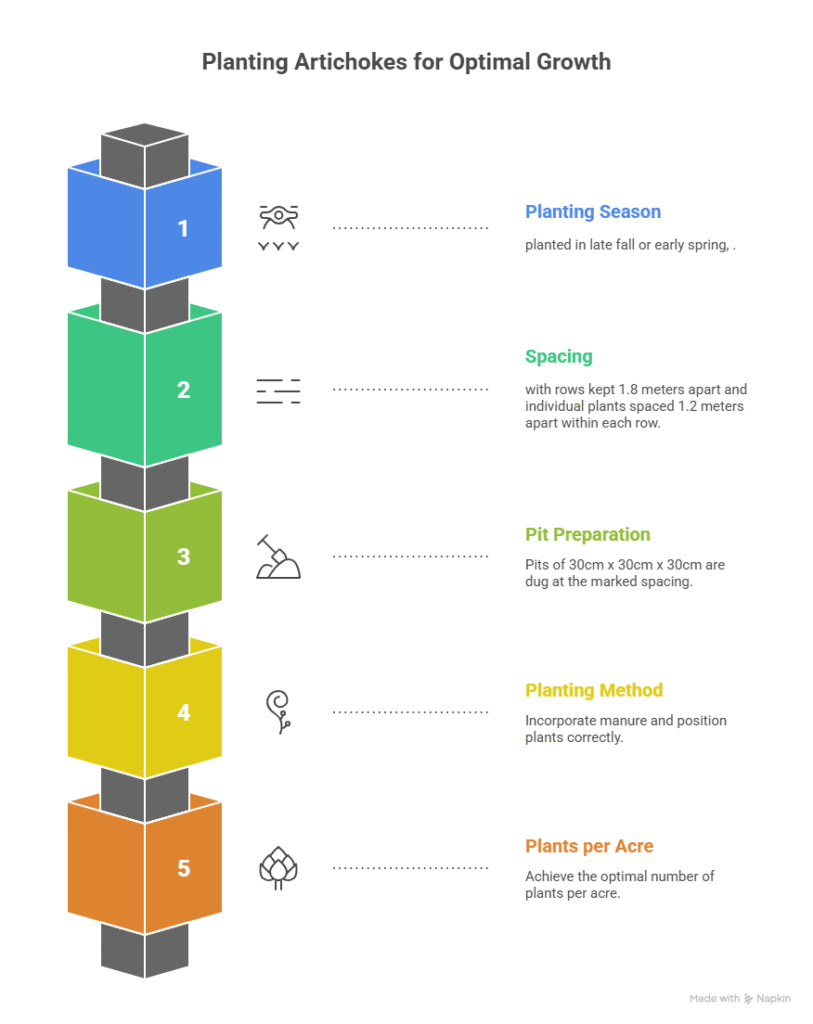
b). Spacing
Maintaining proper spacing in artichoke fields is crucial for good air circulation and light penetration, with rows kept 1.8 meters apart and individual plants spaced 1.2 meters apart within each row.
c). Pit Preparation
Pits of 30cm x 30cm x 30cm are dug at the marked spacing.
d). Planting Method
Well-decomposed farmyard manure (FYM) or compost is incorporated into the soil in each pit before planting. The offshoot or seedling is then positioned at the center, keeping the crown aligned with the soil surface. After filling and firming the soil around the plant, immediate irrigation is provided to ensure proper establishment.
e). Number of Plants per Acre
With a spacing of 1.8m x 1.2m can accommodate approximately 1,873 plants per acre.
Intercropping
In the first year, as artichoke plants are still establishing, their wide spacing can be effectively utilized for intercropping with short-duration crops such as lettuce, radishes, or beans, helping optimize land use and generate additional income.
Irrigation
Artichokes cannot withstand wet circumstances, even though they have deep roots and need constant soil hydration, especially during bud formation. Although furrow irrigation is also frequently employed, drip irrigation is strongly advised since it distributes water directly to the root zone, conserves water, and keeps foliage dry, lowering the risk of disease. To promote deep rooting, irrigation should be given sparingly and deeply; the frequency generally ranges from weekly to bi-weekly, depending on the soil type and environment.
Fertilizer and Manure
Artichokes are heavy feeders. The following application schedule is recommended per acre.
| Application Type | Timing | Material & Dosage |
| Basal Application | Before planting | • 15-20 tons of well-rotted FYM (Farm Yard Manure) or compost • 100 kg N, 80 kg P₂O₅, 80 kg K₂O (as a balanced base fertilizer) |
| Biofertilizers | During final land preparation | Apply 800g of each of the following: • Azospirillum • PSB (Phosphate Solubilizing Bacteria) • Potash Mobilizing Bacteria |
| Top Dressing | In split doses during the growing season, especially after each major harvest flush. | • Side dress with 50 kg N per acre after each major harvest to support growth of secondary buds. |
Weed Control
Manual weeding, mulching, and cautious herbicide use are all necessary for efficient weed control in artichoke farming. While deep hoeing should be avoided to avoid damaging roots, regular shallow hoeing is crucial, especially for young plants. Black plastic mulch or a thick layer of organic mulch, such straw or grass clippings, can help control soil temperature, retain moisture, and inhibit weed growth. Because artichokes are sensitive to a variety of pesticides, selective pre-emergent herbicides can also be used cautiously, adhering to label directions.
Interculture Operation
In artichoke cultivation, intercultural practices such as pruning and managing suckers are essential for sustaining plant health and productivity. Following the main harvest, plants are cut back sharply, with all stalks removed just above the soil surface to stimulate the growth of new, vigorous shoots. In perennial systems, 2–3 of the most robust suckers are retained for the next season, while the others are removed to avoid overcrowding and maintain strong plant vigor.
Flowering and Fruit Management
In artichoke cultivation, the harvested “fruit” is actually the immature flower bud, with the main central bud, or “king head,” developing first and being the largest. After its harvest, smaller lateral buds begin to develop, and to produce larger, premium buds, growers may remove the smallest lateral buds, allowing the plant to concentrate its energy on fewer, higher-quality buds.
Pest and Disease Management
Common Pests
Aphids
Aphids are common pests in artichoke cultivation that feed by sucking sap from the plant, resulting in reduced vigor and honeydew secretion, which can promote sooty mold growth. They can be effectively controlled using natural predators such as ladybugs or by applying insecticidal soaps and neem oil. For chemical control, a systemic insecticide like Imidacloprid can be used at a dose of 0.3–0.5 g per liter of water, applied as a foliar spray, ensuring thorough coverage of affected areas.
Artichoke Plume Moth
The larvae of the artichoke plume moth bore into the buds, making them unmarketable and causing significant yield loss. Management strategies include using pheromone traps to monitor and reduce adult moth populations, introducing biological control agents like Trichogramma wasps, and applying targeted insecticides. Recommended chemical treatments include Bacillus thuringiensis (Bt) at 2–3 g per liter of water or Spinosad at 0.5–1 ml per liter, sprayed directly onto buds and infested plant parts for effective control.
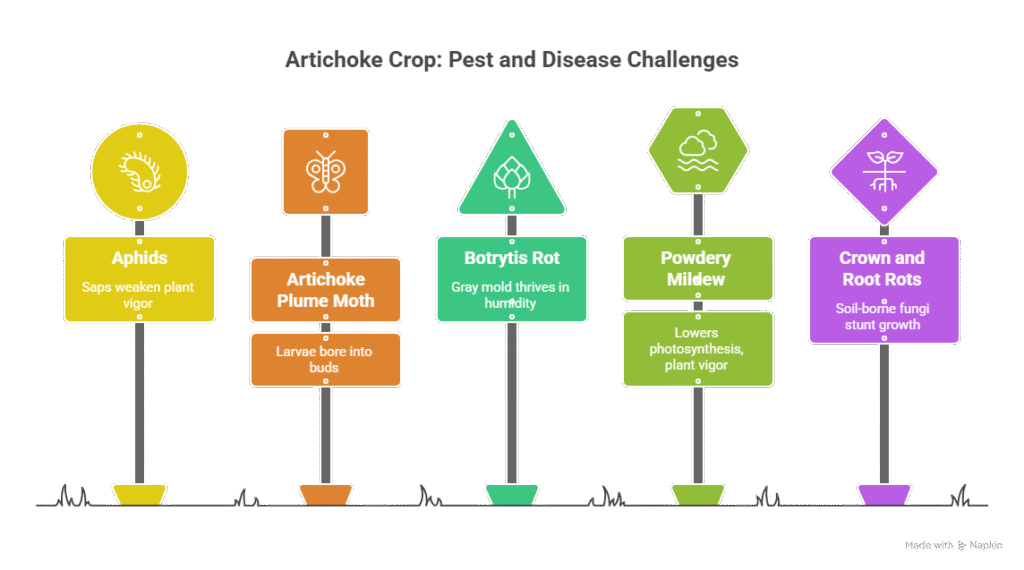
Common Diseases
Botrytis Rot (Gray Mold)
Botrytis rot is a fungal disease that thrives in wet and humid conditions, causing gray mold on artichoke buds, leaves, and stems. Effective management includes maintaining good plant spacing to improve airflow, using drip irrigation to keep foliage dry, and applying fungicides. Recommended chemical control involves spraying with Mancozeb at 2–3 g per liter of water or Copper Oxychloride at 3 g per liter, applied every 7–10 days during favorable conditions for disease development.
Powdery Mildew
Powdery mildew can lower photosynthesis and overall plant vigor. It manifests as a white, powdery fungal growth on leaves. Applying sulfur-based fungicides, maintaining enough airflow, and planting resistant cultivars are all part of management. To ensure complete coverage of both leaf surfaces, wettable sulfur can be sprayed every 10–14 days at a rate of 2-3 g per liter of water.
Crown and Root Rots (e.g., Verticillium Wilt)
The roots and crowns of artichoke plants are impacted by these soil-borne fungal infections, which can cause stunted growth and plant mortality. The key is prevention, which can be accomplished by using certified disease-free planting material, rotating crops with non-host crops, and having great soil drainage. If required, treating the soil with 4–5 g of Trichoderma-based biofungicides per liter of water can help preserve young plants by suppressing harmful fungi.
Harvesting
Indicators of Maturity
Artichoke buds are ready for harvest when they have reached full size but remain tight and compact. The bracts, or scales, should be thick, fleshy, and completely closed. A gentle squeeze of the bud should show a slight “give,” indicating optimal maturity. Overripe buds become tough, start to open, and reveal the purple flower, which reduces their market value.
Harvesting Method
Harvesting artichokes is a labor-intensive, manual process. Using a sharp knife, each blossom is gently cut off the plant, keeping 1-2 inches of stem attached, for handling and freshness preservation. Due to the delayed development of buds, harvesting often occurs multiple times per week to ensure that buds are harvested at their best.
Grading
Immediately after harvest, artichoke buds are graded based on their size, tightness, and overall quality. This grading process ensures that only premium buds reach the market, while smaller or slightly damaged buds are sorted separately, maintaining consistent standards and maximizing profitability.
Yield
Yield in this crop varies significantly depending on the cultivar, age of the plantation, and management practices. In the first year, annual production typically ranges from 907 to 1,814 kg per acre, while from the second year onwards, established perennial plants can yield between 2,721 and 4,535 kg per acre. With proper care and management, a plantation can remain productive for 5–7 years before requiring replanting.
Cost of Investment per Acre for Artichoke Farming
| S.N. | Categories | Cost of Investment (NRs.) |
| 1 | Land Preparation | 15,000 |
| 2 | Seed | 5,000 |
| 3 | Nursery Management | 10,000 |
| 4 | Planting | 5,000 |
| 5 | Fertilizers and Manure | 10,000 |
| 6 | Irrigation | 9,000 |
| 7 | Weed Control (pre & post-emergence) | 7,000 |
| 8 | Pest & Disease Control | 5,000 |
| 9 | Harvesting | 5,000 |
| 10 | Miscellaneous Costs | 5,000 |
| Total Cost | 76,000 |
Annual Maintenance Cost per Acre for Artichoke Farming
The annual maintenance cost of NRs. 60,000 covers recurring expenses such as irrigation, fertilizers, weed and pest management, pruning, and labor. These costs ensure healthy plant growth, high yield, and production of marketable artichoke buds throughout the year.
Income per Acre from Artichoke Farming
| Year | Estimated Yield / Acre (Kg) | Market Price (NRs/kg) | Total Income (NRs.) |
| 1st | 1,185 | 60 | 71,100 |
| 2nd | 3,242 | 60 | 194,520 |
| 3rd | 4,484 | 60 | 269,040 |
| 4th | 4,090 | 60 | 245,400 |
| 5th | 3,193 | 60 | 191,580 |
Analysis of Artichoke Farming Profit Per Acre
| Year | Total Income (NRs.) | Initial Investment | Annual Maintenance | Total Cost | Net Profit/Loss (NRs |
| 1 | 71,100 | 76,000 | 60,000 | 136,000 | -64,900 (Loss) |
| 2 | 194,520 | – | 60,000 | 60,000 | +134,520 |
| 3 | 269,040 | – | 60,000 | 60,000 | +209,040 |
| 4 | 245,400 | – | 60,000 | 60,000 | +185,400 |
| 5 | 191,580 | – | 60,000 | 60,000 | +131,580 |
| Total | 76,000 | 300,000 | 376,000 | +595,640 (5-Year Total Profit) |
Artichoke farming requires a high initial investment of NRs. 76,000, and when combined with annual maintenance costs, this results in a first-year net loss of NRs. 64,900, which is typical for perennial crops that need time to establish. The investment is fully recovered by the second year, with cumulative profits turning positive at NRs. 69,620, marking the start of profitability.
Yield and profit peak in the third year, generating an estimated net profit of NRs. 209,040, and remain high in the fourth year before declining in the fifth. Despite the initial loss, the total net profit over a five-year cycle reaches NRs. 595,640, demonstrating that artichoke farming offers excellent long-term returns for farmers able to manage the upfront costs.
For more: Ash Gourd Farming Profit Per Acre
For More: Pea Farming Profit Per Acre
Sources
Food and Agriculture Organization (FAO)
University of California Agriculture & Natural Resources (UC ANR)
European Plant Protection Organization (EPPO)
Punjab Agricultural University (PAU)
Tamil Nadu Agriculture University (TNAU) – Agritech portal
Indian Council of Agricultural Research (ICAR)
Nepal Agricultural Research Council (NARC)
U.S. Department of Agriculture (USDA).
Ministry of Agriculture and Livestock Development (Nepal)
Disclaimer: This crop farming profits assume optimal conditions. Actual results may vary depending on climate, market prices, and farm management practices.
